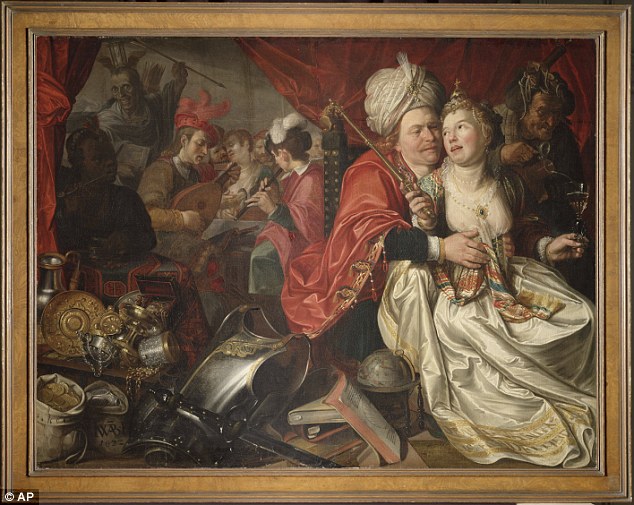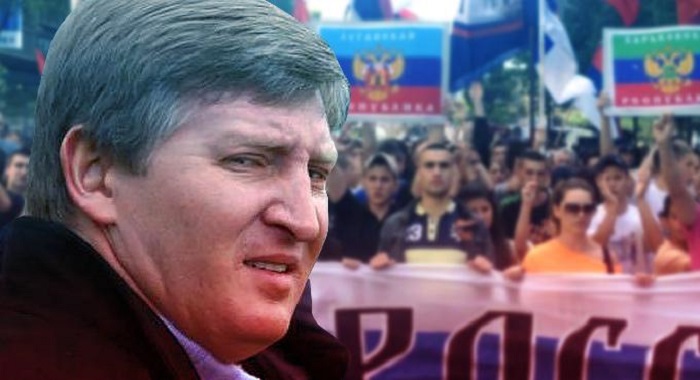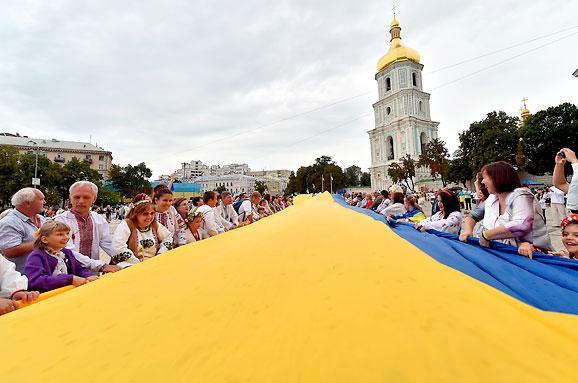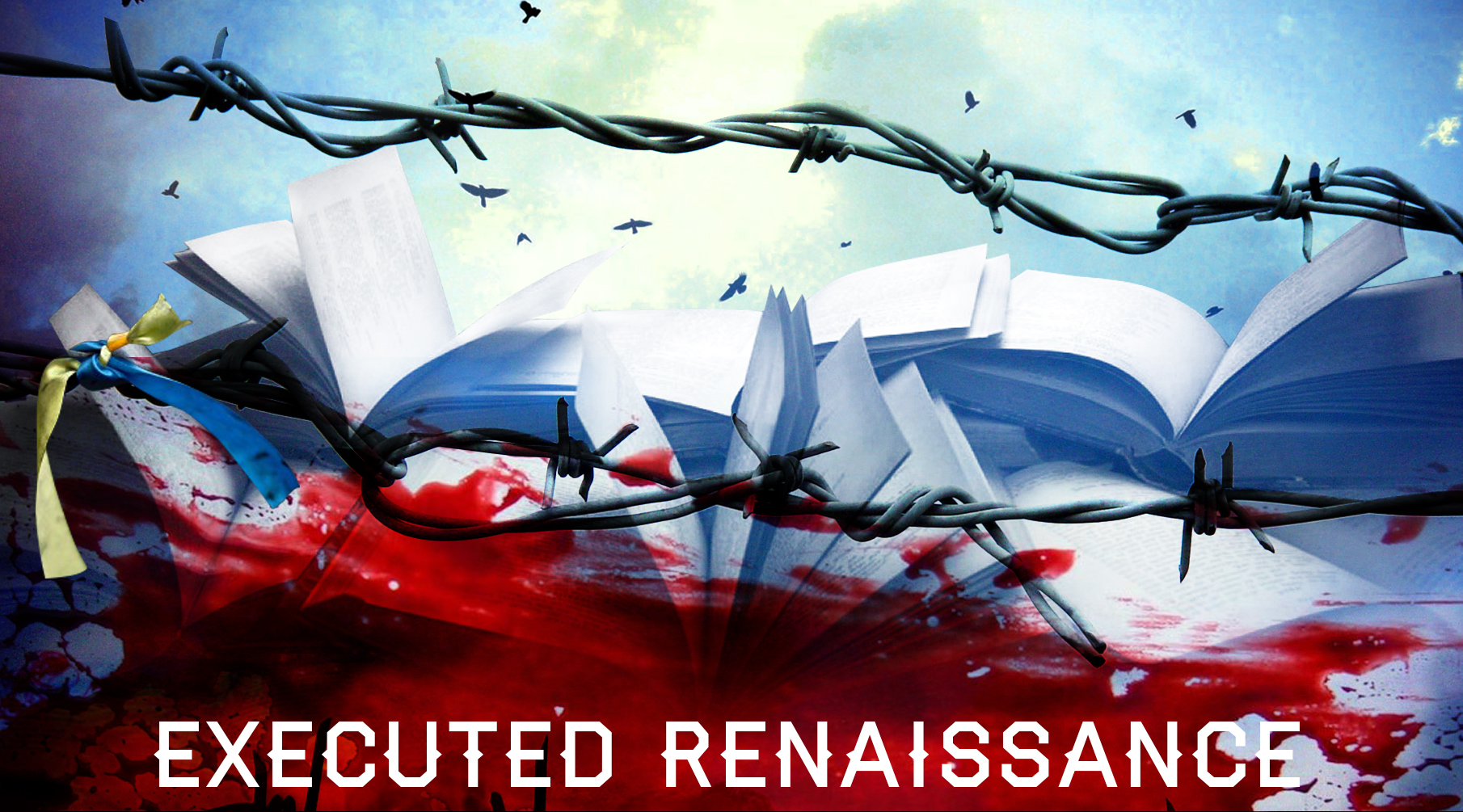New details are being added on a daily basis to the resounding and murky story of the missing Dutch paintings that allegedly have been found in Ukraine. The scandal, which could significantly damage Ukraine’s image, demands that Ukrainian authorities respond quickly and effectively to what is happening.
On the part of the media, it is important to analyze what has happened with the utmost objectivity.
Let us begin with the generally known facts.
During the night of January 10, 2005, a theft took place at the Westfries Museum (in the northwestern Dutch city of Hoorn). A collection of 24 paintings by Dutch painters of the XVII century and around 70 silver objects were taken.
On December 7, 2015 Dutch mass media, quoting Westfries Museum Director Ad Geerdink and art investigator Arthur Brand, reported that:
- The stolen valuables have been located in Ukraine, possibly in the Donbas;
- The paintings were being held by members of the OUN volunteer battalion who, supposedly, found them in an abandoned building of a former associate of Yanukovych, which is located in the combat zone;
- A person called Borys Humeniuk, who claimed to be the commander of the OUN battalion, contacted the Dutch embassy in Ukraine and met with Arthur Brand (whom the museum had authorized to negotiate the return of the stolen paintings) and expressed readiness to return the stolen property for a reward;
- After the parties failed to agree on a price, the contacts were broken;
- Oleh Tiahnybok, head of the Svoboda party, and Valentyn Nalyvaichenko, the former head of Security Service of Ukraine (SBU), are supposedly involved, according to Dutch media.
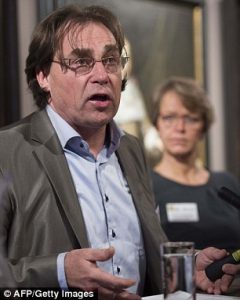
Ad Geerdink and Arthur Brand
First, it is worthwhile to review the interview conducted by Les Dyman, a correspondent for Dzerkalo Tyzhnia (DT.UA), with Ad Geerdink, the director of the Westfries Museum:
How did you find out the stolen art was in Ukraine?
The Embassy of the Netherlands received a phone call in July 2015 from a fighter (referring to Borys Humeniuk — Ed.) who stated that he had all 24 paintings. The embassy staffer who spoke with him asked for proof and received a photo of one of the paintings with a copy of a Ukrainian newspaper attached. Thus, we saw only one painting. We have to take on faith their claim they have the entire collection.
Did you contact Interpol in connection with this case?
All the information in our possession was turned over to representatives of the Ukrainian government, the Ukrainian police and the General Prosecutor’s office. We contacted Interpol in early September this year.
In other words, (you contacted Interpol) after negotiating the return of the paintings, right?
I wouldn’t call it negotiations. That would mean that we were engaged in a dialogue regarding the return of the paintings. No, in reality Mr. Borys Humeniuk phoned the Dutch Embassy and stated that his fighters had found the paintings in a villa that supposedly belonged to one of the former associates of the former president Viktor Yanukovych. He said that they had saved these paintings while risking their own lives. Therefore, they wanted to reach an agreement with the Netherlands regarding the return of the paintings. We asked a very experienced and professional person, Arthur Brand, to conduct the dialogue in our name. Mr. Brand travelled to Kyiv on August 7, 2015 and met with Borys Humeniuk to clarify all the conditions. It turned out (Humeniuk) wanted a very large amount of money since he believed he was in possession of a collection worth 50 million Euros. Based on the auction prices of similar paintings by the same artists, Mr. Brand determined that the collection was worth 1.3 million Euros for all 24 paintings, provided they were in good condition.
Mr. Brand made it very clear that the collection is worth half a million Euros in its current condition. In the art world it is common to pay a reward to the finder of artwork that is equivalent to 10% of its worth. That is why we offered Mr. Humeniuk 50,000 Euros for the return of the paintings.
During the conversation it became clear Mr. Humeniuk was not very happy with Brand’s arguments. He said he had to speak with the fighters in his unit and then he would get in touch. But he never called again.
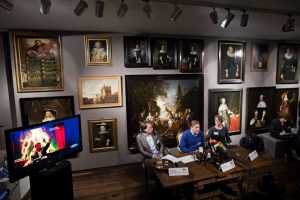
Where did the meeting with Humeniuk take place?
In a restaurant not far from the Dutch embassy in Kyiv. Representatives from the embassy, Brand, Humeniuk, and an interpreter were present at the meeting.
So you did not contact Interpol and international institutions but only dealt directly with Humeniuk?
When it comes to crimes related to art, the suspect may hide the stolen works very well. And when the police arrest him he can pretend he does not know or understand anything. And it would be difficult to prove the opposite. This is why we first met Mr. Humeniuk half-way, who told us that he supposedly wanted to turn over the paintings. But after he did not respond to our proposal, we turned to the Ukrainian government and to Interpol.
Why did you not turn to Interpol in 2014 but only in September 2015?
At that time we had a completely different story. A Ukrainian published a photo of one of the stolen paintings on a Ukrainian site and asked what it was. It was one of the stolen works. Police investigated this information but the matter reached a dead end — it was impossible to determine who had published the photo on the Internet. And we lost any clues until Mr. Humeniuk contacted the Dutch embassy.
Maybe the collection was in Ukraine all this time and maybe not. We don’t know for sure. But all these circumstances force us to assume the paintings had been on Ukrainian territory for a long time. Therefore, we turned to Interpol when we already knew the paintings were in Ukraine.
Why did you decide to hire Arthur Brand?
He is an art specialist. He determines if artworks and antiques are offered for sale lawfully. He has a very good reputation and experience in returning artworks.
We did not wish to conduct the discussions ourselves due to lack of experience. Therefore, Mr. Brand became our representative.
Didn’t you think that it would have been significantly safer to turn to the Dutch and Ukrainian police than to establish unofficial contacts through intermediaries?
Place yourself in the position of the museum. We did not want to inform all possible agencies, preferring to talk first. After all, the main goal was to return the stolen art. But when it became clear they actually wanted to rob us, then we went to the police and all the agencies. When the conversation with Mr. Humeniuk did not lead anywhere we decided to inform the governments of Ukraine and the Netherlands. We asked for help, gave them all the information we had. But we did not see any action on the part of Ukraine. We reported that to our diplomats and politicians. “How can it be that all the information has been turned over, but there is no action? After that our minister of foreign affairs turned to Foreign Minister Klimkin and President Poroshenko.

How did the names of Tiahnybok and Nalyvaichenko appear in this matter?
Arthur Brand conducted his own investigation. You know the art underworld is not that big. It may appear strange, but if someone offers 24 stolen paintings this information spreads instantly. Therefore, Brand turned to his contacts in Eastern Europe and found out there was a direct contact between the battalion and Oleh Tiahnybok. Also during the investigation the name of Valentyn Nalyvaichenko was mentioned very often. Of course, fighters do not act on their own, but there are people who tell them what to do with the paintings. We turned over this information to the Ukrainian government.
Aren’t you afraid the publicity and the use of unofficial contacts in the case of the paintings runs the risk of their destruction?
Of course such a risk exists. However, we have reliable information that the paintings are being sold, not all at once but individually. And this means that the artwork stolen from us can vanish into thin air and be lost forever. Therefore, we accepted this risk since we have no choice. We hope that the information given to the Ukrainian government will somehow help to return the paintings.
But if they sell them and they leave Ukrainian territory, we will have to start all over again and track each one of the 24 paintings separately. This is why we had to go public, hoping to prevent the sale…

Problems with the Dutch narrative
First. Mr. Geerdink stated “I would not call it negotiations. This would mean that we were engaged in a dialogue about the return of the paintings.” However, the contacts he described between Humeniuk and Brand (the person who was acting in the name and on behalf of the museum) cannot be called anything other than “negotiations” and a “dialogue” about the return of the paintings. In world practice there have been quite a few cases where stolen valuables were returned to their legal owners, including museums, after unofficial searches and the subsequent payment of ransom. In these instances, intermediaries with appropriate specific experience are used and who take on such an assignments for pay (Mr. Brand obviously belongs into that category). Museum administrators can be understood since they are primarily interested in the return of the stolen art. Smart and trained intermediaries are needed to avoid becoming victims of scams or getting involved in illegal activities. Strictly speaking, the museum did not engage in secret negotiations — hence the immediate explanation by Geerdink. But in reality it did — through Brand. And after these illegal negotiations fell through, the museum director, whose statements have been readily reproduced by Dutch media, angrily demanded that Ukrainian authorities returned the stolen items to the legal owner immediately and without compensation. Although in the interview with DT.UA Geerdink presented his claims more diplomatically.
Second. We do not question the qualifications of Mr. Brand as a specialist in antiques. However, we have a right to question his skills as a private detective, his awareness of Ukrainian realities and the depth of his political knowledge. The speed with which he “established” the involvement of Tiahnybok and Nalyvaichenko with the stolen paintings and the peremptory way he reached his conclusions are troubling. He is claiming that it was none other than the leader of Svoboda and the former head of the SBU who sent Humeniuk to negotiate. He also states that it was supposedly Nalyvaichenko who offered the stolen paintings to the German criminal world. Furthermore, he claims that the OUN battalion has dark connections with certain circles in Kazakhstan, Tajikistan and Afghanistan. This is what follows from the press release published on Brand’s personal site. The fact that these completely unsubstantiated assertions have been readily picked up by the Dutch press is not surprising. Especially if it had been stirred up by exterior forces.
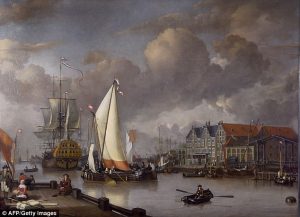
Third. Mr. Geerdink could not fail to understand that, after creating the uproar, he has practically ended any chance of getting the paintings back. We are not talking about great works of art (as confirmed by Geerdink and Brand), and for this reason it is unlikely that anyone would run the risk of acquiring widely publicized, but not very valuable works. Unless it is some ardent fan of paintings of West Friesland somewhere in “Tajikistan or Afghanistan.” Therefore, whoever has these stolen works would probably find it simpler to burn them than to face serious problems for dubious profit. Moreover, we have substantial information (from diplomatic sources) that the Ministry of Foreign Affairs of the Netherlands strongly recommended that the museum not make this story public. But Geerdink and Brand ignored this advice. “We took on this risk because we really had no choice,” Geerdink explains. Let us assume that he really sees his only chance of retrieving these paintings through a public official appeal to Ukrainian authorities. But if you are counting on the help of another country it would hardly be a good idea to tarnish the reputation of that country. “Black hole,” a country where “lying is common,” dark forces,” “neo-Nazis,” “war crimes,” “fascist party” — this is the terminology that fills the texts and news stories about the “painting scandal” and is interspersed with shots of scowling people in camouflage and the photo of Tiahnybok saluting. In the period of several days Geerdink and Brand, along with countless Dutch commentators, succeeded in forming in mind of the average Dutch resident, who, honestly speaking, takes little interest in events in Ukraine, an image of Ukraine that is an explosive mixture of Somalia and the Third Reich. A reasonable question arises: do these people really want the Ukrainian state to help them find the paintings?
The alleged Ukrainian trace
Borys Humeniuk, the main protagonist in this scandal, has presented his own version of events. His rambling testimony appeared in several media. According to Humeniuk, in the summer of 2014 (when he was deputy commander of the OUN battalion), he received information about the paintings from unidentified persons. Supposedly, someone somewhere in the Donetsk suburbs found several paintings in an abandoned building and shared that information with him. In the summer of 2015 (when he was no longer with the battalion), he again received information from unidentified persons (it is not clear if these were the same persons as before) that this was the collection stolen in Holland in 2005.
Who are these people? Humeniuk states that he does not know for sure. On Hromadske TV he stated that these were possibly fighters from “one of our sabotage and reconnaissance groups” that are active on enemy territory. He also states that he does not know any of these people, has not seen the paintings, has not met anyone who has seen the paintings. He vaguely talks about unknown persons who phoned from unfamiliar phone numbers, and that these people know “the locations of these paintings.”
Where were the painting found? Humeniuk says he does not know the exact location, but mentions “suburbs” and “neighborhoods.” On several occasions he has indicated that it is territory not under Ukrainian control. According to our version, it could be the Pisky region (where the front line is currently located) or positions near town of Spartak, which Ukrainian troops left in the beginning of the year. According to our data, there were buildings (dachas) in this area that belonged to at least three persons that match the description of “Yanukovych associates” and who could be interested in antiques.
Specifically, these could be the following: the former prosecutor general Gennadiy Vasyliev, the oligarch Viktor Nusenkis and Anton Pryhodskyi, the former “consigliere” of the fugitive president. A person familiar with the tastes of these former masters of the region as well as with the shadow market of “valuables” claims that Nusenkis was interested primarily in icons. Vasyliev visited antique stores, but was not known to have any special love for art. However, Pryhodskyi was not only a collector, but also a supplier of paintings at Yanukovych’s court. It has been reported that the unsinkable Anton Pryhodskyi was driven out from Yanukovych’s presence when the latter found out that some of the artwork Pryhodskyi had supplied turned out to be fake. Our informer states that the paintings stolen in Holland never appeared on the black market and if one of the influential Donbas people had acquired them he would have known about it.
We will not argue, but will note that Pryhodskyi had many contacts, a wide circle of specific acquaintances, and (at the time) almost unlimited means, and that he was not in the habit of advertising his purchases. It is possible, though unlikely, that the paintings were accidentally acquired by some less known moneyed character in the area, but this is speculation, nothing more.
The role of Humeniuk

Why did these “unknown persons” get in touch specifically with Humeniuk? He bragged on Hromadske TV that he knows many artists, has “a large collection of paintings” and that he has been “making money by selling paintings on the art market for the past 10 years”.
Humeniuk also claims that he did not ask for any ransom, did not refer to the OUN battalion, did not mention “any fighters from his unit” and that he was motivated simply by the selfless desire to return the stolen valuables to the rightful owners, provided they are really in Ukraine.
The former OUN fighter Mykola Kokhanivskyi, in his comments to DT.UA, called Humeniuk “an adventurer and a swindler who engages in petty theft”. “I did not immediately become aware of his real nature,” Kokhanisky explains. “It’s true, that he was my deputy at one point, in fact the fourth person in the battalion. He was responsible for community relations and volunteer support. The position required a talkative, sociable person. As a matter of fact, he then he tried to destroy the battalion. As it turned out, he stole 7 cars donated by volunteers. And in March this year he was thrown out of the battalion for failing to follow orders.”
It should be noted that Dutch journalists are calling Humeniuk an OUN commander and say they suspect OUN fighters of harboring the paintings. Actually, Humeniuk was never an OUN commander and since March has had no connection to the battalion. Futhermore, the volunteer battalion itself does not exist. In mid-year most of the battalion fighters joined a separate unit of the 93rd Brigade of the Armed Forces of Ukraine. Some 30 OUN fighters remain in a separate unit and, according to our information, are stationed in the Pisky region.
As far as is known nothing has ever tied Tiahnybok and Nalyvaichenko to the OUN battalion. Humeniuk’s only indirect connection to the Svoboda party is that he ran on the party’s platform in a local election.
There was one major inconsistency in Humeniuk’s testimony. If he did not see the paintings, where did he obtain the photo of the “Peasant Wedding” painting that he gave as evidence to the embassy staff? DT.UA posed the question to Humeniuk, who vaguely replied that it was sent “as an MMS or email” he could not remember. The photo he sent to the embassy was probably by mail. He could not remember exactly “when he received the photo or from whom.” We will leave it up to the readers to judge the credibility of these recollections.
The photo of the “Peasant Wedding” (along with the attached “Ukraina Moloda” newspaper used as proof the painting was in Ukraine) was the main argument that convinced the Dutch museum administrators to believe that the paintings were in Ukraine.
Is that really true? We asked an expert who, on condition of anonymity, said there are techniques that make it possible to determine from a photo whether it is an original, a copy or a reproduction. But the poor quality of the photo in question makes such an examination practically impossible. Furthermore, he says that it has already been established that this photo has been manipulated with the help of a photo editing program, and that the chances of doing an effective examination are, therefore, close to zero.
If one assumes the photo was actually made in Ukraine and that it depicts the original, then Humeniuk’s claim that the paintings are located on territories under control of the “separatists” is not convincing. The “Ukraina Moloda” newspaper that is photographed along with the painting is dated July 2015. Who would have brought in a current Ukrainian publication into the so-called Donetsk People’s Republic? Did someone specifically cross the frontline with the newspaper in hand, take the painting out of hiding, photograph it with the newspaper, return, and then send a photo to Humeniuk?
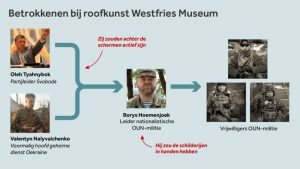
There is yet another detail tied to the photo. Let us return to the Geerdink interview again. He has claimed that still in 2014 “a Ukrainian published the photo of one of the stolen paintings on a Ukrainian site and asked what it was. It turned out to be one of our works.” What Ukrainian? What site? The journalists at the 1+1 TV channel were the first ones to become interested in these circumstances. To quote the channel’s TSN news service broadcast of December 8, this year:
“On the museum site there is information that in January last year police found a color photograph of one of the stolen paintings on a Ukrainian site. TSN is attempting to repeat these steps, but on the web there is only one forum where ‘Illarion2011’ in February 2014 posts several photos and asks about this painting. This forum is Russian. He receives answers that the painting is stolen. He explains that ‘someone tried to sell it to me,’ then he disappears without answering other questions.” TSN found the same user on other forums dealing with the appraisal of paintings, coins or statues. He signs his name “Vadim from Ukraine.”
Thus, the site is a Russian and not a Ukrainian forum. The only indication that the question could have been posed by a Ukrainian is the username. The user could be from Ukraine. Or from Russia, Or Tajikistan. Or Afghanistan.
Therefore, so far there are no indications that the paintings are located (or used to be located) in Ukraine. The relevant authorities should be looking into this matter. But they have not demonstrated particular vigor. Why not?
Problems with the investigation
Let’s review the dates.
According to Geerdink, after negotiations with Humeniuk fell through “all the information we collected was transferred to Ukrainian authorities, Ukrainian police and the prosecutor’s office. We turned to Interpol sometime in the beginning of September this year,” he says.
According to our unofficial information, the Ukrainian Interpol office received the appropriate request for information in October.
We also know that a liaison officer from the Dutch embassy contacted the Ukrainian Interpol office, informing it about negotiations between Brand and Humeniuk and about the photo of the stolen painting. The officer named the persons who were supposedly contacted as potential buyers for the paintings.
In November, during the visit of President Poroshenko to the Netherlands, the Dutch side informed the President about the history of the stolen paintings. This was confirmed on December 8 by Ukraine’s Foreign Minister Pavlo Klimkin, who immediately stated that “Ukraine’s Interior Ministry is seeking the Dutch paintings.”
But, as it turned out, it was not seeking them. Earlier this week at a special meeting with representatives of the presidential administration, the Interior Ministry representatives reported that relevant information has not been submitted to the Unified State Register and that criminal proceedings have not been initiated because there is no legal basis yet for these actions. There is only the request by the Dutch embassy employee to the Ukrainian Interpol office, whereas they need an international legal order from the Netherlands or through the General Prosecutor’s office or other channels. Only then will they launch the investigative and search efforts.
On December 10, this thesis was publicly stated by the Chief of the National Police Khatia Dekanoidze. “We are waiting for the official inquiry from the Prosecutor General of the Netherlands, addressed to the General Prosecutor of Ukraine,” she said. “I want to assure you that we are open and are waiting in Ukraine for official representatives of the investigation who can examine these materials and conduct questioning along with our investigators.”
The Deputy Interior Minister Tigran Avagyan told DT.UA that he fully agrees with the chief of the National Police. He pointed out that since November 7 the investigation of such cases is the responsibility of the National Police. He also said that, according to the Deputy Head of the National Police Oleksandr Vakulenko (who oversees the criminal department), the agency has not been provided with any information from the Dutch embassy officer.
Therefore, the process of investigation has yet to be started at the Prosecutor’s office, and the National Police are waiting for the formal request. This explains why Boris Humeniuk has not yet been questioned.
Ukraine has known about this matter since fall this year. Since September, according to the Dutch, and at the latest since November. But it was not prepared for the scandal that erupted on December 7. This was indicated by the belated public reaction and by the confusion that existed (as we were told) during the meeting at the presidential administration. There was no thoughtful PR response prepared and it became necessary to make excuses and to answer the strident, unsubstantiated accusations, improvising along the way. The received information was not even verified. Sources at the Interior Ministry and the Security Service claim they have not received any requests to verify relevant data recently.
This is surprising, considering the circumstances and the role that Holland can play in Ukraine’s geopolitical destiny.
Netherlands has sheltered the shadowy capital of our oligarchs. And from that perspective, they are not exactly in a position to instruct us on civilization and democracy. Netherlands is in no hurry to return the “Scythian Gold” to Ukraine which has been stuck there after the occupation of Crimea. Also from that perspective, they are not in a position to be outraged by Ukraine’s reluctance to return paintings, whose presence in Ukraine has never even been confirmed by anyone.
Repercussions and next steps
Although the Dutch Parliament has approved the EU-Ukraine Association Agreement, the country has not yet completed the process of ratification, since the ratification documents have not been filed. The situation is aggravated by the fact that on April 6 next year a consultative referendum will be held where Dutch voters will express their views of whether or not their country should ratify this document. The vote will be regarded as a recommendation. But it will be the first vote after the adoption by the Netherlands of its law on referendum. The current Dutch government, which is losing popularity, would find it difficult to ignore the decision of its citizens. If they vote “no” to the Association Agreement this could become a pretext for another review in the Dutch Parliament and who knows how the Dutch deputies would vote this time.
Furthermore, in February 2016, the Security Council of the Netherlands is release the final report on the causes that led to the crash of flight MH-17. And it is clear that much will depend on the language contained in the report. There is one particular example that should be mentioned: earlier the Dutch Security Council rejected a proposal to include in the report’s description of the circumstances of the crash of the Malaysian flight the mention that the territory near the town of Snizhne was controlled by illegal armed groups at the time of the incident.
In short, Ukraine should be especially attentive and responsive to Holland at present. However, Ukraine has not been responsive and has not foreseen the potential scandal. Now it will have to make extraordinary efforts to convince the Dutch citizens before April 2016 that Ukraine is not Somalia with elements of the Third Reich and that, at the very least, it has a right to expect the association with Europe.
Ukraine is waiting for the official international legal order to open the criminal proceedings. Even though there was time and (given the circumstances) the possibility at least to review the information that had been transmitted by the Dutch still in the fall. In the “paintings affair” the government’s clumsiness has been exposed as in an image.
When asked to comment, the well-known attorney Oleksiy Volkov said that the appropriate Ukrainian authorities could have brought the necessary data to the Unified State Register of Pre-trial Investigations and could have begun the investigation on their own initiative without waiting for the international legal order. He referred to article 214 of the Criminal Code, which states that “the investigating prosecutor … after determining the circumstances from any source that indicate a criminal offense is obligated to enter the appropriate data into the Unified State Register of Pre-trial Investigations and begin the investigation.” According to Volkov, the appeal of the Dutch embassy employee or the publication of information in the press provided sufficient basis for taking necessary steps.
One can only hope that competent authorities will promptly deal with the consequences of their own tardiness that had been brought about by the clumsiness of the government that apparently was too engrossed in the expected visit of Vice President Joe Biden.
One also has to hope that the National Police will rapidly determine the circle of individuals that need to be questioned to help trace the missing paintings or, at a minimum, would help determine if these paintings were even located in Ukraine. In addition, the Security Service will need to conduct an effective investigation of the “Russian trace” that has been mentioned frequently in the press but which has not yet been professionally investigated.
There is no doubt that this “paintings scandal” is very beneficial for Russia. Right away two foreign diplomats confirmed off the record that, according to their information, Moscow has been actively stirring up the scandal behind the scenes in the Dutch media. But Moscow’s possible involvement in the affair still has to be proven. Unfortunately, the version that someone tried to benefit from the “spin” surrounding previously stolen valuables cannot be discounted either.
This is an ambitious task for investigators and analysts. Their reputation is at stake and so is the reputation of their country.




